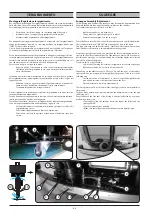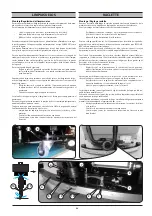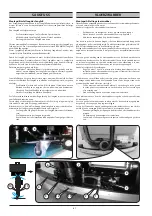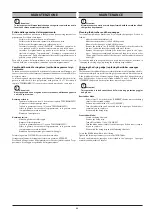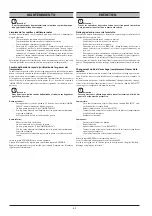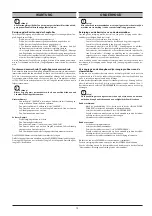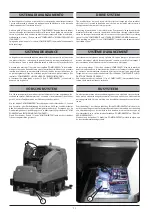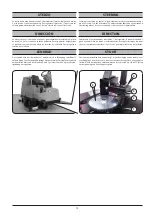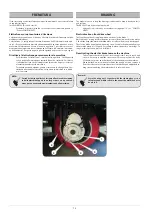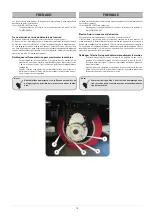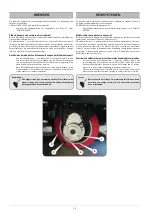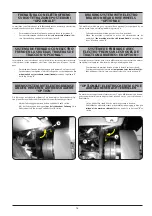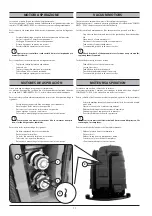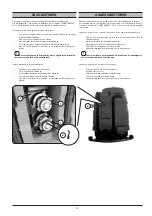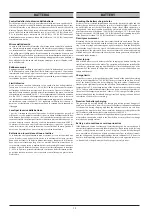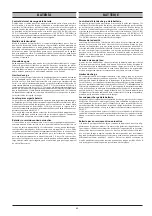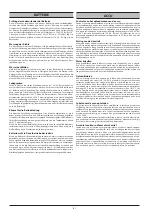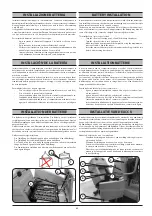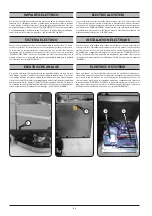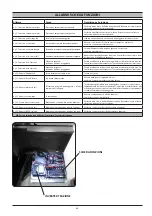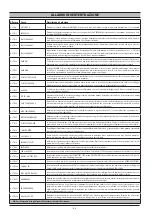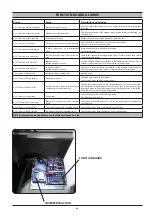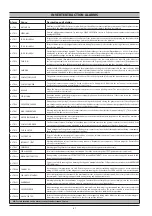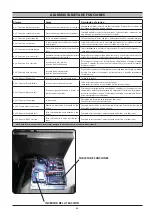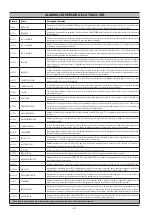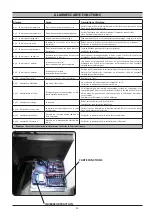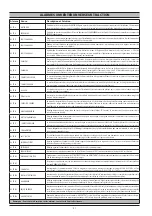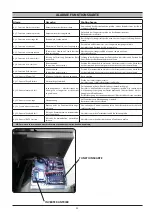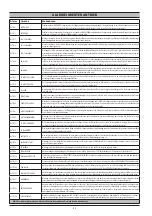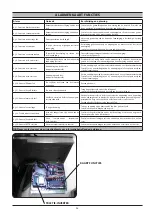
79
BATTERIA
Controllo dello stato di carica della batteria
Poiché é acquisito che intercorre una relazione diretta tra il peso specifi co dell’e-
lettrolito e lo stato di carica della batteria, si assume la misurazione del peso spe-
cifi co dell’elettrolito come effi
cace e corretto controllo dello stato di carica della
batteria. Quando la batteria é carica ed in condizioni normali, con l’elettrolito al
giusto livello la densità dell’elettrolito sarà di circa 1.260 (30° Bè) riferita a 30°
C. Se la densita é invece compresa tra 1.26 (30° Bè) e 1.20 (24 Bè), la batteria é
parzialmente carica, mentre se la densità é inferiore a 1.14 (18° Bè) la batteria é
completamente scarica.
Misura della densitá
La misura della densitá dell’elettrolito é il più importante controllo su una batte-
ria . Questa misura va quindi eseguita con la massima cura mediante il densime-
tro, introducendolo a siringa e prelevando una quantitá di elettrolito suffi
ciente
a far galleggiare il galleggiante. Fare attenzione che la sommitá di questo non
tocchi la pera di gomma o non resti attaccato con la capillaritá alle pareti di vetro.
Se si dovesse fare una misura di densitá dopo un’aggiunta di acqua distillatá si
deve attendere che la densitá sia diventata omogenea in tutto il liquido conte-
nuto nell’elemento.
Rabbocco acqua
Aggiungere acqua distillata in ogni singola cella della batteria dopo aver carica-
to la batteria per portare il liquido al livello 6mm sopra le piastre . L’operazione
inizialmente avverrá dopo ogni carica, in seguito i rabbocchi potranno avvenire
meno spesso a seconda dell’esperienza del responsabile, ma mai oltrepassando
la settimana fra l’uno e l’altro rabbocco.
Limiti di carica
Non é necessario ricaricare la batteria se la densitá, alla fi ne della giornata di
lavoro non é scesa al di sotto di 1.24 (28° Bè). L’abuso piú comune riscontrato
nell’impiego della batteria per trazione é la sovraccarica. Questo solo fattore, se
applicato continuamente, puó abbreviare drasticamente la durata. La massima
temperatura raccomandata é di 45° C. Se la temperatura dell’elettrolito aumenta
di oltre 10/12° C rispetto alla temperatura ambientale, si puó avere la sovracca-
rica indipendentemente dal valore della temperatura raggiunta. Se nella batte-
ria rimane una carica residua del 5-10% segnalata sul display del cruscotto , è
permesso il traferimento e l’asciugatura ma non la rotazione delle spazzole ne
il lavaggio.
Locali per la carica della batteria
I gas che si sviluppano durante l’operazione di carica, presentano pericoli di
esplosione, occorre quindi assicurararsi che vi sia libera ventilazione della bat-
teria durante l’operazione di carica e che i contatti dei morsetti siano sicuri da
eventuali scintille. I locali nei quali caricare le batterie di accumulatori devono es-
sere ben aerati, in essi non si devono verifi care temperature superiori a 40/45° C.
Se attraverso le fi nestre non vi é suffi
ciente aerazione vi si provvede con speciali
condotti di scarico, che non debbono sboccare nelle canne fumarie. Quando é
necessario, il ricambio deve essere reso rapido mediante ventilatori.
Batteria non in servizio continuo o inattiva
Se la batteria non viene utilizzata in modo continuo, occorre sottoporla ad una
carica di rinfresco una volta al mese, anche se le misurazioni del peso specifi co
danno valori elevati. Se la batteria rimane inattiva per lunghi periodi di tempo
deve essere conservata in un luogo fresco e asciutto. Una volta al mese deve es-
sere caricata, con una carica completa, fi nché si noti in tutti gli elementi un vivace
sviluppo di gas e le letture di tensione e di peso specifi co rimangono costanti per
3 - 4 ore. In ogni caso, prima di rimettere in servizio una batteria rimasta per lun-
go periodo inattiva, essa deve essere ricaricata e controllata per un giusto livello
elettrolitico.
BATTERY
Checking the battery charge status
As there is a direct relationship between the specifi c electrolyte weight and the
battery charge status, measuring the specifi c electrolyte weight is assumed to
be an effi
cient, proper check of the battery charge status. When the battery is
charged and in normal conditions with the electrolyte at the right level, the
electrolyte density will be about 1.260 (30° Bè) referring to 30° C. Instead, if the
density is between 1.26 (30° Bè) and 1.20 (2 -Bè), the battery is running low, while
if the density is less than 1.14 (18° Bè) the battery is completely fl at.
Density measurement
Measuring electrolyte density is the most important check on a battery. This me-
asurement must be performed with the utmost care with a hydrometer, introdu-
cing it with a syringe and removing enough electrolyte to fl oat the fl oat. Make
sure that the top of it does not touch the rubber pear or remain attached with
the capillarity to the glass walls. If you were to measure the density after adding
distilled water, you must expect the density to be homogeneous in all the liquid
contained in the element.
Water top-up
Add distilled water to each battery cell after charging the battery to bring the
liquid level to 6mm above the plates. The operation will take place initially after
each charge, afterwards topping up will take place less often depending on the
experience of the person in charge, but never going over a week between one
top up and the next.
Charge limits
It is not necessary to recharge the battery if the density at the end of the working
day has not dropped below 1.24 (28°Bè). The most common abuse found in the
use of the battery for traction is overcharging. This factor alone, if applied con-
tinuously, can signifi cantly shorten the duration. The maximum recommended
temperature is 45 °C. If the temperature of the electrolyte increases by more than
10/12° C above ambient temperature, there can be an overcharge, regardless of
the value of the temperature reached. If there is 5-10% charge remaining in the
battery indicated on the dashboard display, travel and drying is allowed but not
the rotation of the brushes or washing.
Premises for battery charging
The gases which develop during the charging operation present dangers of
explosion. It is, therefore, necessary to ensure that there is adequate ventilation
for the battery during charging and that the terminal contacts are safe from
any sparks. The premises where the accumulator batteries are charged must be
well-ventilated, with temperatures that do not exceed 40/45 °C.
If there is not suffi
cient ventilation through the windows, special extraction ducts
are provided, that must not lead to the fl ues. When necessary, the air exchange
must be done quickly via fans.
Battery not in continuous service or inactive
If the battery is not used continuously, it must be charged once a month, even if
the specifi c weight measurements show high values. If the battery is idle for long
periods of time, it must be stored in a cool, dry place. It must be fully charged
once a month, until you notice a lively development of gas in all the elements
and the voltage and specifi c weight readings remain constant for 3 - 4 hours. In
any case, before putting a battery that has been idle for a long period into servi-
ce, it needs to be charged and checked for proper electrolyte level.

